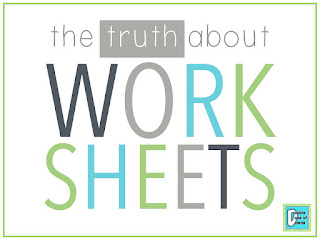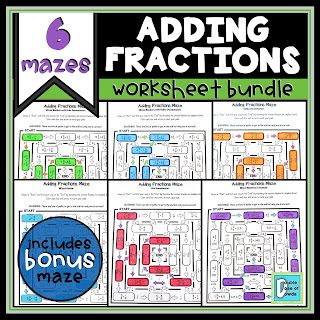Can I say something a little controversial? Just to be safe, lean in close because I am going to whisper ... I am not opposed to worksheets.
Eek! I said it! I’ll wait by my door for the angry mob with pitchforks to arrive.Oh good, no one is here yet. So until then, let’s chat.
In case you haven’t heard, worksheets have gotten a bad reputation and have been labeled by some as a poor resource for student learning. While I get where that argument comes from, I don’t think they are this shameful practice that no longer has a place in the classroom.
Since we are being real, I’ll go one step further and admit that when I hear someone flat-out oppose all worksheets, I can’t help but wonder how far removed they are from the classroom. Do you know what I mean?
Now, let me be clear before going on. When I say worksheets, I am NOT talking about those silly word searches or the other time-filling, busywork nonsense that I remember doing piles of as a kid. With the high expectations placed on us and our students, we need to be better than that.
Here’s what I see as reality. Worksheets absolutely have a place as part of well-planned, thoughtfully-structured lessons and are not good only for throwing together last-minute sub plans.
Where Do Worksheets Fit In?
In my mind, the flow of an ideal lesson typically looks something like this:- A quick “hook” to engage students in what they will be learning
- Activate students’ previous learning to connect to today’s learning targets
- Introduce the new learning with a brief mini-lesson
- Include references and tools such as anchor charts more times than not
- Engage in skill practice that is gradually released (“I Do, We Do, You Do”) and, generally speaking, increases in rigor
- Give students feedback on their work
- A quick lesson closure and exit ticket
_________________________________________________________________________________
Worksheets can fit beautifully into that skill practice section of a lesson. Here are two questions I ask myself when choosing a worksheet:
1. Does the worksheet meet the rigor of the on-grade-level standard/skill I’m focusing on?
If the answer to Question #1 is not an absolute yes, then I throw out the worksheet and do not go any further UNLESS I am intentionally using the worksheet to differentiate for specific learners who are above or below grade level expectations of that skill. Sometimes I will pull a worksheet that is slightly above or below grade level for a quick small group mini-lesson to fill a gap skill for my lower students or challenge my higher students.
2. Is this worksheet going to engage students for an appropriate amount of time?
This question has two parts. The first is straight-forward enough. Is there something about this worksheet that will keep students’ attention and motivate them to work? I often look for worksheets with a game- or puzzle-like feel to them because they are inherently more fun. And the more I can “trick” kids into doing work because it is fun, the harder they will work and the more practice they will get. If there’s a way to make something a competition, that’s an added bonus because students will work even harder to win. I actually love to turn worksheets into fun challenges or games!
The second part of this question is about the amount of time a worksheet will take students to complete because here’s the thing … INSTRUCTIONAL TIME IS PRECIOUS. I cannot feel okay about students taking longer to cut or color or glue or ***insert here whatever fun gimmick goes along with said worksheet*** than they spend actually working on practicing a skill. I need their focus, attention, and effort on standards-based work. It’s that simple.
One final note about time is that research suggests that students are engaged in instruction for up to one minute per year old they are before their brain needs a modality switch (change from lecture to video back to lecture, etc.). That means, for example, a 5-year-old will be attentive for about 5 minutes and a 12-year-old will be attentive for about 12 minutes. Interestingly enough, this increase maxes out at 15 minutes no matter a person’s age. I share this because if a worksheet is part of your instruction, it should not exceed 15 minutes for students to work through. If it does, find a way to break up the practice (even if it means physically cutting a paper) to keep students engaged.
_________________________________________________________________________________
Let’s say you and I are in agreement that worksheets are not necessarily the mark of a poor teacher, but you have a peer who might disagree (or maybe you are still that peer). Here are some overall PROs worth considering.
Sure, there are some cons to worksheets as well, even if they pass the 2-Questions test from above.
Problem: Worksheets are one more thing to grade.
Problem: Worksheets lack higher-order thinking skills.
So where do you land on worksheets in your classroom and what are your best practices for choosing and implementing them with your students? I’d love to know your thoughts in the comments below.
If you want to check out some of the maze worksheets we’ve created like our popular Adding Fractions Maze Bundle (pictured below) to engage students in math practice, you can see all of them here. And we always love to hear what new topics you’d like for us to add to our future to-do list!
The second part of this question is about the amount of time a worksheet will take students to complete because here’s the thing … INSTRUCTIONAL TIME IS PRECIOUS. I cannot feel okay about students taking longer to cut or color or glue or ***insert here whatever fun gimmick goes along with said worksheet*** than they spend actually working on practicing a skill. I need their focus, attention, and effort on standards-based work. It’s that simple.
One final note about time is that research suggests that students are engaged in instruction for up to one minute per year old they are before their brain needs a modality switch (change from lecture to video back to lecture, etc.). That means, for example, a 5-year-old will be attentive for about 5 minutes and a 12-year-old will be attentive for about 12 minutes. Interestingly enough, this increase maxes out at 15 minutes no matter a person’s age. I share this because if a worksheet is part of your instruction, it should not exceed 15 minutes for students to work through. If it does, find a way to break up the practice (even if it means physically cutting a paper) to keep students engaged.
_________________________________________________________________________________
Let’s say you and I are in agreement that worksheets are not necessarily the mark of a poor teacher, but you have a peer who might disagree (or maybe you are still that peer). Here are some overall PROs worth considering.
Worksheets SHOULD Provide Opportunities for:
- differentiation for students working above or below level without drawing the attention of the entire class;
- students to work and get feedback;
- practice that feels more FUN than working straight out of a textbook;
- teaching skills not tasks (by this I mean teachers should not spend too much time teaching students instructions for how to do a task/activity/game; selecting familiar, repetitive tasks that students enjoy can free up students’ time and brainpower to practice the skill at hand);
- practicing some skills in isolation, which can be important whether you are teaching letter “t” in Kindergarten or teaching how to graph inequalities in Algebra;
- communicating learning to parents;
- cleaning up “gap skills” or those concepts that students missed in previous years but that they need to know in order to be successful in the current standard
_________________________________________________________________________________
Sure, there are some cons to worksheets as well, even if they pass the 2-Questions test from above.
Potential Problems and Solutions with Even the Best Worksheets
Problem: Worksheets use paper.- Possible Solution: Make sure you are being intentional with what you print. In addition, consider printing so you can cut papers into half- or quarter-sheets. Or try turning a paper worksheet into digital practice with Google Forms or Slides.
Problem: Worksheets are one more thing to grade.
- Possible Solution: Students need feedback, so either look for worksheets that are self-checking, give students access to the answer key to check themselves afterward, or let peers check their work.
Problem: Worksheets lack higher-order thinking skills.
- Possible Solution: Great teachers can use worksheets selectively to build up to higher-order questions and tasks.
_________________________________________________________________________________
So where do you land on worksheets in your classroom and what are your best practices for choosing and implementing them with your students? I’d love to know your thoughts in the comments below.
If you want to check out some of the maze worksheets we’ve created like our popular Adding Fractions Maze Bundle (pictured below) to engage students in math practice, you can see all of them here. And we always love to hear what new topics you’d like for us to add to our future to-do list!
Share this post or save it on Pinterest so you can always find it:




I am also not opposed to worksheets- they can serve a purpose!
ReplyDeleteFor sure! I'm glad I'm not alone!!!
Delete